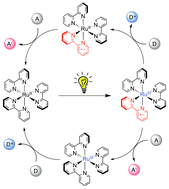The photophysics of photoredox catalysis: a roadmap for catalyst design
Abstract
Recently, the use of transition metal based chromophores as photo-induced single-electron transfer reagents in synthetic organic chemistry has opened up a wealth of possibilities for reinventing known reactions as well as creating new pathways to previously unattainable products. The workhorses for these efforts have been polypyridyl complexes of Ru(II) and Ir(III), compounds whose photophysics have been studied for decades within the inorganic community but never extensively applied to problems of interest to organic chemists. While the nexus of synthetic organic and physical-inorganic chemistries holds promise for tremendous new opportunities in both areas, a deeper appreciation of the underlying principles governing the excited-state reactivity of these charge-transfer chromophores is needed. In this Tutorial Review, we present a basic overview of the photophysics of this class of compounds with the goal of explaining the concepts, ground- and excited-state properties, as well as experimental protocols necessary to probe the kinetics and mechanisms of photo-induced electron and/or energy transfer processes.

- This article is part of the themed collection: Primer

 Please wait while we load your content...
Please wait while we load your content...